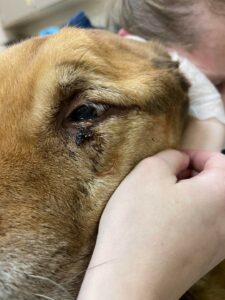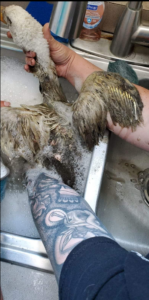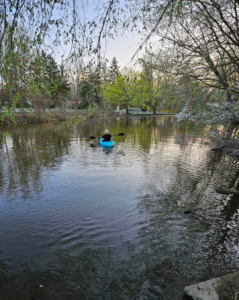April is Prevention of Cruelty to Animals Month, which is a 30-day campaign that was initiated in 2006 by the ASPCA (The American Society for the Prevention of Cruelty to Animals). This month-long observance recognizes the need for protection and human advocacy of all animals.
Firstly, what constitutes animal cruelty?
Well, while most of us can easily write our own definition of animal cruelty, the legal literature can be dependent on location. In Ohio, ORC 1717.01b defines animal cruelty, torture, and torment as “every act, omission, or neglect by which unnecessary or unjustifiable pain or suffering is caused, permitted, or allowed to continue, when there is a reasonable remedy or relief. In our state, we also have Godard’s Law, multiple statutes of the Ohio Revised Codes, as well as even local/city ordinances guarding the welfare of animals”.
dependent on location. In Ohio, ORC 1717.01b defines animal cruelty, torture, and torment as “every act, omission, or neglect by which unnecessary or unjustifiable pain or suffering is caused, permitted, or allowed to continue, when there is a reasonable remedy or relief. In our state, we also have Godard’s Law, multiple statutes of the Ohio Revised Codes, as well as even local/city ordinances guarding the welfare of animals”.
With the definition of animal cruelty in mind, which acts of animal cruelty do we instantly think of? Puppy mills and dog fighting, right?
Of course these acts constitute as animal cruelty, but what about cat hoarding due uncontrolled breeding, untreated medical conditions, starvation, crippling hoof overgrowth on farm animals, pet rabbits that can’t get away from their soiled bedding, or outdoor pets that don’t have a warm shelter in the winter? These are just a few examples of animal cruelty that occurs right in our own backyard. From a protection standpoint, it’s wonderful that so many acts and omissions constitute animal cruelty, but from a compassion standpoint, it is truly devastating to digest that we are essentially surrounded by so many facets of animal cruelty – seemingly everywhere, all the time.
In a web article entitled “Prevention of Cruelty to Animals Month”, National Today shares some disturbing, current statistics that resonate with animal lovers everywhere:
Every 60 seconds – the frequency of animal abuse in the world.
65% – the percentage of all abused animals that are dogs.
10 million – the number of animals who die each year in the U.S. from abuse alone.
250,000 – the average number of animals who are victims of hoarding by their owners every year.
10,000 – the number of puppy mills in the United States.
97% – the number of animals killed and tortured every year that are farm animals.
So, how to we combat this overwhelming transgression?
- Education

Education is the first tool in our toolbelt. Depending on the circumstances, the first step in helping victims of animal cruelty is often just taking the blinders off. People come from all walks of life; culturally, academically, sociogenically, economically, health status-wise. Is that an excuse for animal cruelty? Of course not – but, consider this: how many animals are we helping if we judge, scorn, and remove a pet from a neglectful/abusive owner? Well, one. How many animals are we helping if we attempt to educate the owner and help prepare them to become a better animal owner/handler? Potentially every animal that person will encounter in the future. Education may not work in every scenario, but it gives people the opportunity to correct unintentional wrong doings against animals, and even pay it forward to others.
2. Altruism
Hand-in-hand with education, selfless acts are what changes lives for the better, whether human or animal. If the neighbor that has trouble feeding their pet also can’t feed themselves, what can we do for them? Maybe you don’t know of any struggling animal caregivers, but you might live right down the street from an animal shelter that needs volunteers or supplies, or perhaps you have a widespread social media audience and have the ability to promote low-cost spay and neuter services. Selfless acts can often be of little inconvenience to us but can make a world of difference in the eyes of an animal or another person.
3. Advocacy
This tool can easily be the most complicated and challenging for everyone to utilize. Looking at the “See Something, Say Something” national campaign that promotes awareness of the signs of terrorism, these four words can easily be adapted to raising so many other awarenesses, including signs of animal cruelty. Animals are voiceless. Every single humane investigation and rescue effort is the result of one person speaking up. Anonymity can always be discussed, but positive change in the lives of animals has never happened by remaining silent.
Lastly, who do you call?
In Lorain County, our humane officers operate out of Friendship Animal Protective League. They can be reached at 440-322-4321 ext. 225 and humane@friendshipapl.org. If your call is not

immediately answered, our officers encourage you to leave a message and you will be responded to as soon as possible. Local law enforcement such as police and sheriff departments also can work in the capacity of Ohio humane officers, as they enforce the Ohio Revised Code.
Remember, as said by Daphne Sheldrick, “It’s not enough to love animals; we must actively protect and preserve them. It’s our duty and responsibility as custodians of this planet”.



